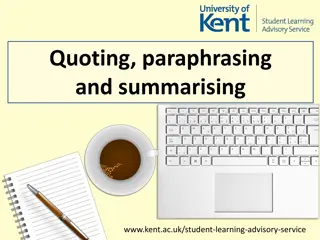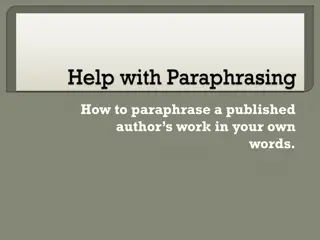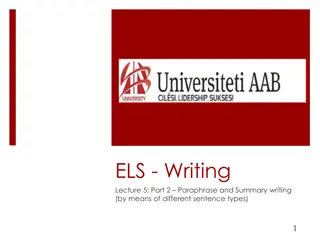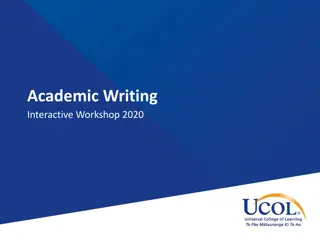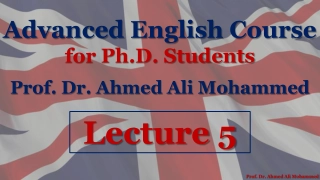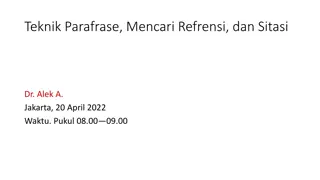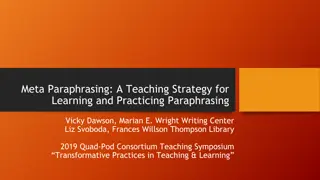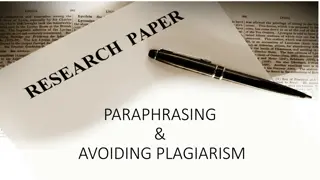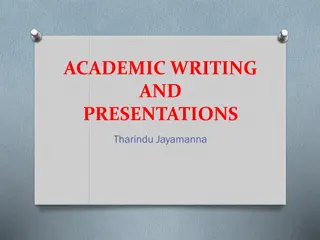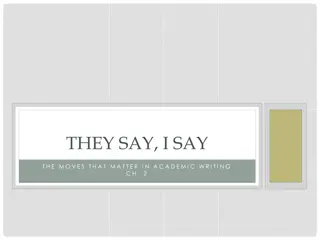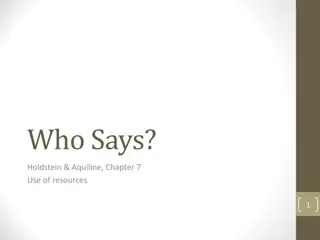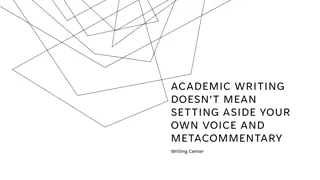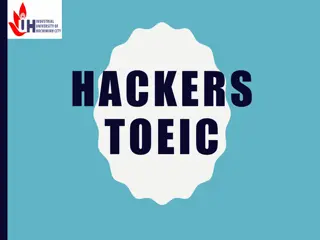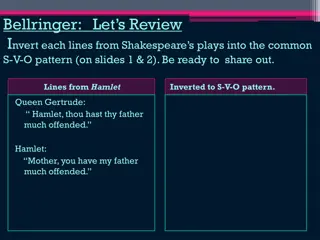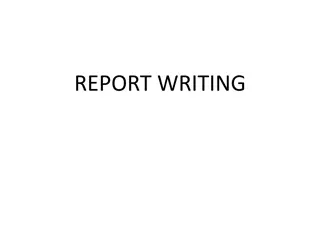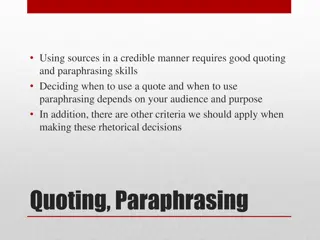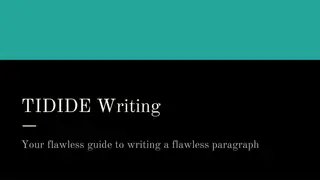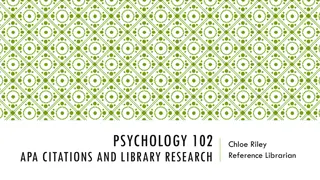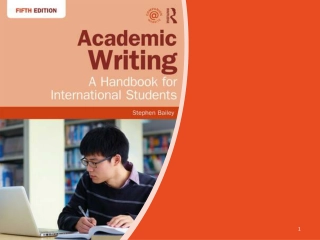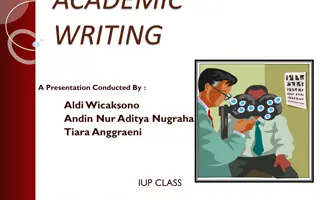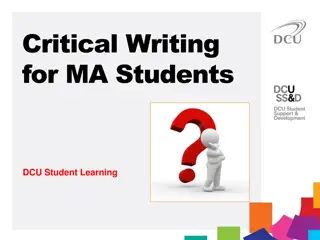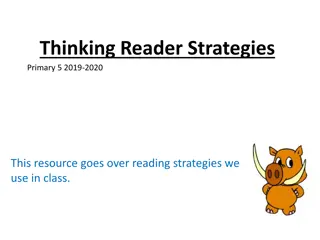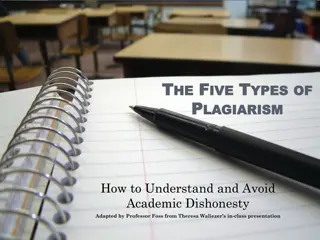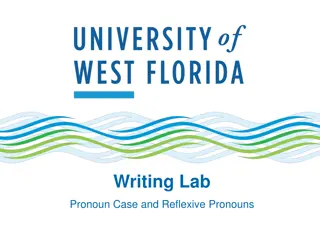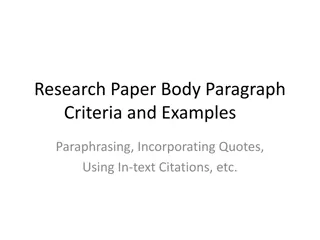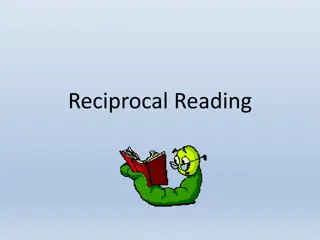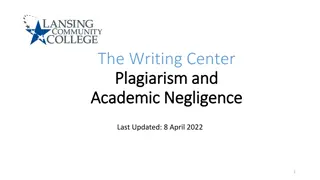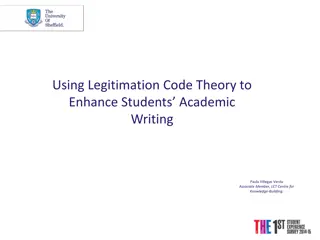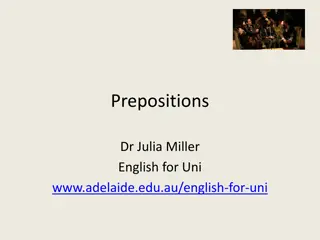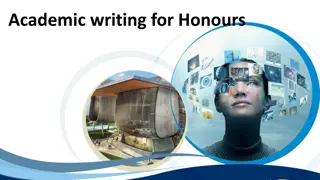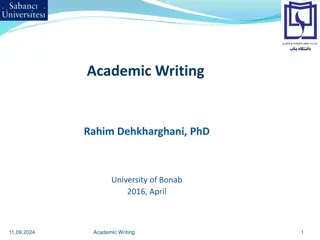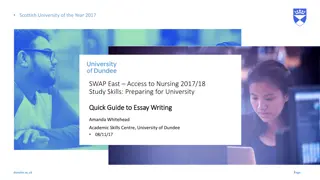Mastering Academic Writing: Paraphrasing and Summarising Techniques
Understanding the importance of paraphrasing and summarising in academic writing is crucial to avoid plagiarism and effectively integrate evidence. The difference between the two techniques lies in the length and depth of the content. Effective paraphrasing involves skillfully rephrasing original content to maintain the essence without copying, while summarising condenses information into a concise overview. Assessing student paraphrasing examples reveals the need for improved skills to preserve academic integrity.
Download Presentation

Please find below an Image/Link to download the presentation.
The content on the website is provided AS IS for your information and personal use only. It may not be sold, licensed, or shared on other websites without obtaining consent from the author. Download presentation by click this link. If you encounter any issues during the download, it is possible that the publisher has removed the file from their server.
E N D
Presentation Transcript
Academic Writing Skills: Paraphrasing and Summarising Activities and strategies to help students
Paraphrasing and summarising Why do I need to paraphrase or summarise? to show that you are able to understand and analyse information from a source to avoid plagiarising information to integrate evidence into your writing.
Whats the difference between paraphrasing and summarising? Paraphrase Summary is a similar length to the original is shorter than the original has the same meaning as the original is an overview of the main ideas includes examples and details does not include examples is usually used to provide evidence or support an argument is usually used as background information uses an in-text reference/footnote with page numbers uses an in-text reference/footnote without page numbers
What is effective paraphrasing? Compare the original and the student work. Identify if it is well paraphrased, poorly paraphrased or if it is an example of plagiarism. Student work Original Research is an important part of many assessment types. When gathering research material you must be able to evaluate it for relevance to your topic and your focus. You will need to analyse the material for its facts, arguments, and opinions; select material that is directly applicable to your research; and record the publication details so that you can acknowledge your sources and include them in your reference list (SACE Board of SA 2009, p. 1). Research is important for many assessments. When researching, you need to evaluate the research material for your topic and your focus. You need to analyse it for facts, arguments and opinions. You need to select material that is applicable to your research and record all the publication details so you can include them in your reference list (SACE Board of SA 2009, p. 1).. Answer: This is an example of plagiarism. Even though the original source is acknowledged, too many of the same/similar words or phrases are used.
What is effective paraphrasing? Compare the original and the student work. Identify if it is well paraphrased, poorly paraphrased or if it is an example of plagiarism. Student work Original Research is an important part of many assessment types. When gathering research material you must be able to evaluate it for relevance to your topic and your focus. You will need to analyse the material for its facts, arguments, and opinions; select material that is directly applicable to your research; and record the publication details so that you can acknowledge your sources and include them in your reference list (SACE Board of SA 2009, p. 1). Research is included in many assessment types. When collecting information a student needs to check it to make sure it is relevant. A student mush analyse the information for its facts, arguments, and opinions . A student mush choose information that is directly connected to their research, and write down the details so they can acknowledge where it came from and incorporate into the reference list (SACE Board of SA 2009, p. 1). Answer: This is poorly paraphrased. Even though an in-text reference is included to acknowledge the source, the sentence structure or grammar is not changed the order of the ideas is not changed synonyms are used to change the words.
What is effective paraphrasing? Compare the original and the student work. Identify if it is well paraphrased, poorly paraphrased or if it is an example of plagiarism. Student work Original Research is an important part of many assessment types. When gathering research material you must be able to evaluate it for relevance to your topic and your focus. You will need to analyse the material for its facts, arguments, and opinions; select material that is directly applicable to your research; and record the publication details so that you can acknowledge your sources and include them in your reference list (SACE Board of SA 2009, p. 1). It is common to use research in many different tasks. There are certain points to be aware of when collecting research. These include making sure that it is relevant, analysing the main points, choosing information that is connected to the research topic, keeping a record of all details in order to reference them appropriately (SACE Board of SA 2009, p.1). Answer: This is well paraphrased. Elements that make this paraphrase effective include: changing the sentence structure and grammar changing the order of the ideas using a variety of words to express the same meaning including an in-text reference to acknowledge the source.
How do I paraphrase? It takes practice to paraphrase well. It is a skill that you need to develop. Following these steps may help: Consider using one of the Academic Note-taking templates. This will help you record information about the source and focus on elements of the original text that will help you understand it. Read the original text. Highlight or write notes of the key ideas / facts in your own words. What is the author s position? What reporting verb can you use? Re-read the original to ensure your notes are correct. Write in complete sentences to integrate the paraphrase into your writing. Change the order of the ideas. Change the sentence structure and grammar. Change phrases rather than single words. Check that you have included a suitable in-text reference and noted the details for inclusion in your reference list.
Practise paraphrasing Consider using one of the Academic Note- taking templates. This will help you record information about the source and focus on elements of the original text that will help you understand it. Original Conducting case studies gives you a chance to draw from your knowledge and research, practise your skills of analysis and reasoning, and draw conclusions. As a case study is taken from real life, it can be complex, and different readers of your case study may draw different conclusions (SACE Board of SA 2009, p. 1) References SACE Board of SA 2009, How to conduct a case study, SA
Practise paraphrasing Read the original text. Highlight or write notes of the key ideas in your own words. What is the author s position? What reporting verb can you use? Student work possible answer Original Conducting case studies gives you a chance to draw from your knowledge and research, practise your skills of analysis and reasoning, and draw conclusions. As a case study is taken from real life, it can be complex, and different readers of your case study may draw different conclusions (SACE Board of SA 2009, p. 1) Key ideas: Case studies use what I already know, research, use critical thinking skills, draw conclusions Case studies real-life experiences so the results may be different Author s position: Giving information, stating facts References SACE Board of SA 2009, How to conduct a case study, SA Reporting verbs: States / emphasizes / highlights
Practise paraphrasing Re-read the original to ensure your notes are correct. Write in complete sentences to integrate into your writing Change the order of the ideas Change the sentence structure and grammar Change phrases rather than single words Original Student work possible answer The SACE Board of SA state that doing case studies gives students many skills, such as using what they already know, developing critical thinking skills and making inferences. The Board also emphasize that results may be different because case studies are based on real life experiences. Conducting case studies gives you a chance to draw from your knowledge and research, practise your skills of analysis and reasoning, and draw conclusions. As a case study is taken from real life, it can be complex, and different readers of your case study may draw different conclusions (SACE Board of SA 2009, p. 1) References SACE Board of SA 2009, How to conduct a case study, SA
Practise paraphrasing Check that you have included a suitable in-text reference and noted the details for inclusion in your reference list. Original Student work possible answer Conducting case studies gives you a chance to draw from your knowledge and research, practise your skills of analysis and reasoning, and draw conclusions. As a case study is taken from real life, it can be complex, and different readers of your case study may draw different conclusions (SACE Board of SA 2009, p. 1) The SACE Board of SA (2009, p.1) state that doing case studies gives students many skills, such as using what they already know, developing critical thinking skills and making inferences. The Board also emphasize that results may be different because case studies are based on real life experiences. References SACE Board of SA 2009, How to conduct a case study, SA References SACE Board of SA, 2009, How to conduct a case study, SA
What is an effective summary? Compare the original and the student work. Identify if it is well summarised, poorly summarised or if it is an example of plagiarism. Student work Original Research is an important part of many assessment types. When gathering research material you must be able to evaluate it for relevance to your topic and your focus. You will need to analyse the material for its facts, arguments, and opinions; select material that is directly applicable to your research; and record the publication details so that you can acknowledge your sources and include them in your reference list (SACE Board of SA 2009, p. 1). Research is important and it involves many skills such as evaluation (it needs to be relevant to your research question), analysis (of the information within the material), selection (making sure that the information chosen is suitable and can be connected to the research) and recording (all the publication details so the sources can be used in the reference list and in the writing) (SACE Board of SA 2009). Answer: This is poorly summarised. Even though the original source is acknowledged, too many are included. It is more similar to a paraphrase.
What is an effective summary? Compare the original and the student work. Identify if it is well summarised, poorly summarised or if it is an example of plagiarism. Student work Original Research is an important part of many assessment types. When gathering research material you must be able to evaluate it for relevance to your topic and your focus. You will need to analyse the material for its facts, arguments, and opinions; select material that is directly applicable to your research; and record the publication details so that you can acknowledge your sources and include them in your reference list (SACE Board of SA 2009, p. 1). Research is an important part of many assessment types. When gathering research material, you must use many different skills. Answer: This is an example of plagiarism. The original source is not acknowledged. Too many words/phrases are the same as the original.
What is an effective summary? Compare the original and the student work. Identify if it is well summarised, poorly summarised or if it is an example of plagiarism. Student work Original Research is an important part of many assessment types. When gathering research material you must be able to evaluate it for relevance to your topic and your focus. You will need to analyse the material for its facts, arguments, and opinions; select material that is directly applicable to your research; and record the publication details so that you can acknowledge your sources and include them in your reference list (SACE Board of SA 2009, p. 1). Evaluation, analysis, selection and acknowledgement of sources are all skills that are needed in research, which is included in many different assessment types (SACE Board of SA 2009). Answer: This is well summarised. The original source is acknowledged. An overview of the main idea using the student s own words is used. It does not include too many details.
How do I summarise? Following a similar process as paraphrasing may assist you in summarising well. Consider using one of the Academic Note-taking templates. This will help you record information about the source and focus on elements of the original text that will help you understand it. Read the original text and understand the main ideas. Write down the key points in your own words. What is the author s position? What reporting verb can you use? Re-read the original to ensure your notes are correct. Write these points in your own words. Check that you have included a suitable in-text reference (without page number) and noted the details for inclusion in your reference list.
Practise summarising Read the original text and understand the main ideas. Write down the key points in your own words. What is the author s position? What reporting verb can you use? Student work possible answer Original Key points: - Some different styles of referencing - Depends on subject - Schools should use the same one to make referencing easier for students What system of referencing should be used? There are a number of referencing styles, which are used according to the needs and preferences of different subjects. However, it is easier for students and teachers if a school adopts and teaches a consistent referencing system. The examples of referencing used in this guide are based on the Harvard referencing system, also known as the Author Date system. This style is generally used in the physical, natural, and social sciences. Although the basic principles remain the same, different institutions/publishers use their own variations, so slight differences in use may be observed (SACE Board of SA 2012, p. 1) Author s position: Advisory Reporting verbs Advises, highlights, suggests References SACE Board of SA 2012, Guidelines for Referencing, SA
Practise summarising Re-read the original to ensure your notes are correct. Write these points in your own words. Check that you have included a suitable in-text reference (without page number) and noted the details for inclusion in your reference list. Student work possible answer Original What system of referencing should be used? There are a number of referencing styles, which are used according to the needs and preferences of different subjects. However, it is easier for students and teachers if a school adopts and teaches a consistent referencing system. The examples of referencing used in this guide are based on the Harvard referencing system, also known as the Author Date system. This style is generally used in the physical, natural, and social sciences. Although the basic principles remain the same, different institutions/publishers use their own variations, so slight differences in use may be observed (SACE Board of SA 2012, p. 1) Depending on the subject, different referencing styles can be used (SACE 2012). The SACE Board suggests that the same style should be used to make referencing easier on students. References SACE Board of SA, 2012, Guidelines for Referencing, SA References SACE Board of SA 2012, Guidelines for Referencing, SA
Paraphrasing and summarising tips Remember: Consider your own ideas. What evidence do you need to support your ideas? Consider ideas from the sources, rather than specific words or phrases. What information do you need to include as examples in your writing? Change the grammar / sentence structure and phrases not just single words.
References SACE Board of SA 2009, How to conduct a case study, South Australia SACE Board of SA 2012, Guidelines for Referencing, South Australia



